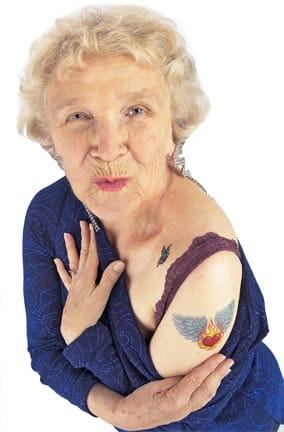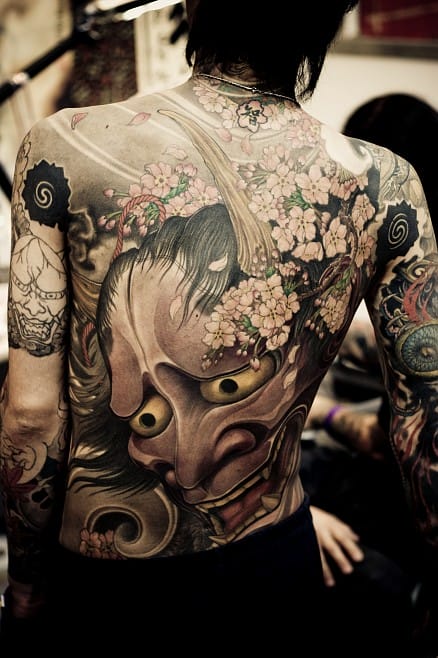Marie McCarthy of Rose Gold’s Tattoo & Body Piercing Parlour sees it over and over. Someone comes to the shop asking for a design that she and her tattoo artists doubt will make a good tattoo. But the customer insists. Soon after, a string of customers arrive, asking for the exact same tattoo. When this happens, Marie always asks, “Who’s responsible?”
The answer is always a celebrity. One time it was Lindsay Lohan, who got the word “breathe” tattooed on her wrist in white ink. Another time it was Miley Cyrus’s tattoo of a cross on the inside of her finger. When a celebrity gets a new tattoo, it sets off a string of imitators who show up in tattoo parlors across the country.
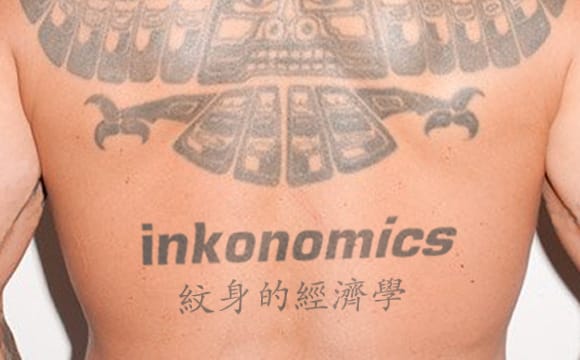
Once a fringe practice associated with sailors, bikers, and criminals, tattoos in America have become more accepted over the past two generations. After years of steady growth, tattoo artists cite popular television series, beginning with The Learning Channel’s “Miami Ink” in 2005, as establishing tattoos as normal and opening the floodgates. Good public data is scarce, but estimates grant the existence of at least 15,000 parlors in the US and $2 billion in annual revenue. Tattoos and body piercings have gone mainstream, imbued with the respectable title of “body art.” Forty percent of people age 18-29 have a tattoo and 25% have a body piercing somewhere other than their ear.
This new popularity of tattoos has created divisions in what has historically been a small, mostly unified scene of tattoo artists and devotees. Artists at shops we visited around San Francisco almost rolled their eyes describing artists with celebrity customers who charge over a thousand dollars for simple tattoos.
The perception that there is money to be made in tattoos has attracted an influx of new players to the industry. Marie regularly suggests to people asking how to become a tattoo artist that “they get some tattoos themselves first.” But other new players are no joke. They are finding success and bringing business practices to the Wild West of tattooing.
Despite its newfound popularity, much of the tattoo industry remains the same. It is a small world of artists who know each other, engage in friendly competition, and are each other’s best customers. The bulk of their business is still “collectors,” people who continuously add new tattoos, many taking weeks and thousands of dollars each to finish. When these artists admit that you can make good money in tattoos, they do so grudgingly.
As with any rebel art movement (think graffiti), they want to stay devoted to their art. Business thinking is eschewed in favor of getting better at the craft. But what will happen as tattooing goes mainstream? The effects are already being seen, from clothing line spinoffs to artists skipping the tradition of learning tattooing through multiyear apprenticeships. Will they survive the invasion of corporate America into their world?
Everyone Gets Tattoos
“One chick came in as soon as her husband died. She was in her seventies. She came right from the funeral. Her husband wouldn’t let her get one. She must’ve wanted a tattoo her entire life.”
~Mike, 415 Tattoo
Mike says that he has tattooed everyone, from bikers to lawyers to sorority girls. His customers range from age 18 (the legal minimum age) up to people in their seventies and the occasional octogenarian. His case is not unusual. Everyone is getting tattoos.
One in five Americans has a tattoo according to polling by Harris Interactive. Tattoos have clearly increased in popularity recently. Polls in 2003 and 2008 found 14% and 16% of Americans had tattoos. And among Millennials (teens and twentysomethings), forty percent have at least one tattoo. If that number surprises you, that is because 70% of Millennials’ tattoos are in spots typically concealed by their clothing.
The most common place that people get ink is on their shoulders and shoulder blades – they are the least painful to get and are both easily displayed in casual settings and concealed in professional ones.
According to Mike, the majority of his customers get tattoos as a memorial. Whether in honor of a departed one, to commemorate a vacation, or to cement quitting drinking, the reasons are often emotional. “Work here is like bartending,” Mike told us. “People tell you everything.”
But not everyone gets tattoos commemoratively. For many it’s simply art and expressive – a number of parlors feel like an art gallery. Others are going for the tough or punk look. And every artist has talked someone out of a tattoo of their boyfriend’s or girlfriend’s name. In general, artists agree that the reasons people get tattoos are varied, without one dominating the others.
Despite the rebel associations of tattoos, artists recognize that what they do “changes people” and they exercise that responsibility wisely. Every tattoo artist we met described talking with teenagers who came in asking for tattoos on their face, hands, or other visible areas. Tattoos aren’t as taboo as they once were, but even with adults, artists recommend that people don’t get tattoos in visible places unless they’re established, retired, or in a more welcoming industry.
Why give up the possibility for profit? “Because it’s the right thing to do,” Paul Stoll, owner of Body Manipulations in San Francisco’s Mission neighborhood told us. “You don’t want to go home knowing that you changed an 18 year old’s life for the worse. Tattoos should be empowering. They should change people for the better. They shouldn’t be a mask.” Paul asked for a face tattoo when he was young. The artist told him that he’d do it if Paul still wanted it in a year. He never got it.
Inkonomics
There is good money to be made as a tattoo artist.
The minimum charge at shops in San Francisco is commonly $60-$85 for a few dots, words, or a basic design that can be done in under an hour. More intricate designs are done at an hourly rate – $150 to $250 an hour is typical – and can cost tens of thousands of dollars.
Artists work as independent contractors at tattoo shops, giving a commission of roughly 50% to the shop or paying an equivalent amount in rent. It’s a high price, but necessary in a business with health concerns and certification requirements. Parlors often provide hygienic materials, while artists spend a couple hundred bucks a month on ink and other supplies. But really customers are paying for the labor of the artist.
Paul Stoll gave an example of a tattoo artist at his shop who did quite well financially. By scheduling her clients to make full use of her day, she often booked 6 billable hours – $900 at $150 an hour. With parlors taking 50% commissions on average, that amount of output comes to $108,000 a year at 5 days a week. This does not include health insurance, time off, and the cost of supplies and maintaining equipment, but artists that successfully keep a full schedule (a matter of booking clients, not just good organization) can push 6 figure salaries.
In a more typical example, Joe Parker of Mom’s Body Shop gave us an idea of his days as an artist. No day is the same. He’s done 28 small tattoos in a day, whereas other days he works on just one or two big pieces. He does not see clients throughout working hours. There are slow days. When asked what would represent a really solid day that he felt good about financially and artistically, he responded “a $500 day.” That represents a few small tattoos or one big one, and under 4 hours of work billed. If maintained every working day for a year, that comes out to a more modest salary of $60,000 – before deducting for the cost of supplies and other expenses.
One member of the tattoo industry also encouraged us to remember that tattoo artists’ hourly wage also represents the cost of their training.
Schools that teach tattooing are opening in response to demand, but the classic way to learn has been to apprentice under an experienced artist. This naturally limits supply, and makes aspiring artists work hard for their education. “It’s tricky,” Perry Doig of Rose Gold’s told us. “You’re training your competition. So you normally take an apprentice only when you’re retiring or to fill a space in your shop.”
Over years of cleaning shop, some drawing, and (in the past) hazing, apprentices learn the basics. Ideally, they’ll pick up on how to build and maintain tattoo machines, the maintenance of a hygienic work environment, and artistic skills like shading. Ready to use tattoo machines are available from catalogues, but quality parlors look down upon them. “You can buy an expensive car,” artist Perry Doig told us, “but if you don’t understand what’s going on underneath the hood…”
Artists at street shops catering exclusively to tourists may learn the basic technique and be done. But for serious tattoo artists, learning the craft is a lifelong devotion. Traveling to tattoo conventions to teach and attend seminars ranging from color theory to machine building is a significant ongoing expense.
Artists always react with bemusement to people trying to barter down prices. “We’re in the business of permanently altering people’s skin,” tattoo artist Joe Parker told us. It should be obvious, but tattooing is incredibly difficult. It’s “putting something permanent on a moving object,” and it requires technical skill and artistic ability.
The potential for profit is there, but tattoo artists are not all sitting on gobs of money. “It’s a misconception that there’s tons of money to be made,” one artist told us. “If you just want to make money, go sell drugs or do something that actually makes money.”
Barriers To Entry
Doing tattoos well is not easy. That is why aspiring artists put up with 2 year apprenticeships spent cleaning shop and observing someone else work.
Artistry aside, however, it is reasonably easy to get into the tattoo business. Artists note that classes are becoming available that range in length from a few weeks to 9 months. Certification doesn’t take more than a few weeks and is inexpensive. (Parlors independently meet standards and get certified by the Department of Health and other bodies.) Machines are a large startup cost as artists will have as many as ten $800 machines, but cheaper models can be bought ready to go for $200.
Even if the result is only that they can draw simple tattoos without a full understanding of the craft, aspiring tattooists can get into the game relatively easily. And with tattoos exploding in popularity and their visibility high thanks to inked celebrities and television shows, there has been an explosion of new entrants to the field.
The newbies skipping out on their initiation into the world of tattoos through long apprenticeships are not exactly popular. Tattoo artists criticize people trying to learn the trade in less than a year who order tools rather than customize tattoo machines themselves. They say that their quality cannot be as good, and they simply don’t respect people getting into tattoos because “they want to be a rockstar” rather than out of a love of the art.
As a result, artists who go on television often lose respect as well. People in the tattoo world describe the shows, with their emotional plot lines and cuts that make it seem like entire back tattoos were finished in one sitting, cheesy or misleading. Artists shake their heads when customers don’t understand why a large tattoo will take multiple sessions. They speak with some frustration about high profile tattoo artists charging thousands of dollars for basic tattoos – in effect charging for their fame rather than the quality of the work.
Asked about their biggest challenge in their business, a number of artists cited the problem of customers not realizing the difference between the quality of different tattoo artists. They worry about losing business to rookie artists that offer tattoos for low prices and hotshots charging well above the hourly rates of accomplished artists on the basis of their marketing.
The Core of the Tattoo World
You’d think that with the popularity of tattoos exploding, artists would sit back and enjoy the windfall. To some extent, this is true. “Business is good, so who cares?” Paul Stoll, owner of Body Manipulations, remarked half seriously. But reactions are mixed.
For most of the artists, the ones descending from the small scene of American tattooing that began around World War II, they’ve always cared more about the art than the money. In the words of Danny Greenwood, who works the counter at Cold Steel American Body Piercing and Tattoo: “The artists who are passionate, that do this to sustain themselves emotionally or spiritually, that’s who I respect.” Paul notes that although his studio’s $150/hour charge is not terribly high for San Francisco, many of the artists like that “it keeps tattoos accessible for people.”
Artists note that their world is a small one – “a culture and a lifestyle” and “a small world of people that network and push the industry forward.” Perry of Rose Gold’s notes that tattoo artists are each other’s best customers and that he spends “more of his time than he should admit on Instagram checking out tattoos and piercings that different artists have done recently.” They constantly try to learn from each other and at conventions. There’s a lot of “friendly competition,” he tells us. Danny informed us that although the Bay Area has 70-80 parlors, only half really care about the art and fit into this world.
It is this small circle of tattoo artists that is concerned about the influx of new artists. Yet their business is largely unchanged. Although more people than ever are getting tattoos, the majority of business remains “collectors”: people who continuously add to their collection of tattoos. It doesn’t matter that more twentysomethings want a tattoo of a word or a rose, people spending fifty thousand dollars on a body suit over the years and people coughing up ten thousand for a back tattoo still make up the majority of artists’ projects.
Depending on their reputation and location, the degree to which parlors depend on walk-ins varies. Some popular shops have 3 year waits; others rely predominantly on tourists walking in the door. Among the shops we spoke with, collectors made up 75% of their business on average and more casual tattooees only 25%.
This is why tattooing is still less of a lunch pail industry and more like any artistic field. Shops do make money churning out basic “flash” tattoos based on pre-drawn designs that take minimal time, creativity, and technical talent. But as collectors make up the majority of the business, and they are interested in original and complex designs, the individuality and prowess of an artist is called for.
So while a lot of profit can be made, the hierarchy is similar to artists in any area. Some people at the top do great financially, many settle contentedly into making only enough to support their art, and aspirants commonly fail. Even after finishing a 2 year apprenticeship with a great artist, aspiring artists don’t make money during their first year. Collectors avoid artists without good portfolios, so they only get the last pick of the walk-ins.
“It’s about quality and doing something different,” Joe told us. “You need to build a pipeline.” By building up a unique portfolio, flyering, and showing their work at conventions, as well as through word of mouth from satisfied customers, artists develop relationships with collectors who will return for work over and over again. Artists travel to do “guest spots” and tattoo at conventions in other cities so that collectors can get tattoos from new artists, but the key to success is developing 50 plus clients that will return for pricey tattoos that take multiple sessions (“like painting parts of a mural”) over and over again for years.
But will that remain true for tattoo artists as the body art scene expands? As more people get tattoos, less of them seem to be respecting the tradition that these artists represent and their devotion to the craft. To reach those customers, branding and customer service may go farther. And that is exactly where insurgents in the tattoo industry are finding success.
The Tattoo Insurgents
“It used to be a secret world of tattoo artists,” Paul tells us. As a store owner with a background in both tattoos and body piercings, he is well suited to wax on the field. “But it’s changing so fast.”
Paul lists off some of the ways that the industry has changed to become more corporate: television shows, Vegas casinos with huge tattoo places, kids with graphic design experience disrupting the tattoo industry by introducing attention to customer service and outreach.
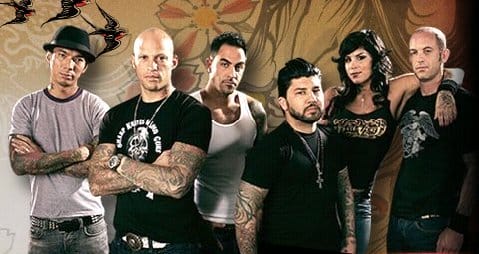
Although the small scene described above is the inheritor of the traditional American tattoo scene, the center of gravity seems like it could be shifting. “At conventions, a lot of the old school guys that developed the techniques are being ignored and left behind,” Paul tells us. New entrants who market themselves well are hustling their way to six figure salaries and attention in the tattoo world. The industry is still thoroughly not corporate, but pioneer businessmen offering 401(k)s, owning multiple shops, and even (gasp) trying to apply the “Starbucks model” to tattooing have arrived.
Looking ahead to the next generation, Paul thinks “the newbies will win. It’s sad, but it’s business.” Whereas the core world of tattoo artists, pursuing their love of the craft over all else, are often picky about the tattoos they do, the new guys will take any project. And they’re more willing to do the classic business work of marketing and managing their time to increase output and keep to appointments. As more busy professionals get tattoos, they will be drawn in by advertising – not portfolios – and expect professionalism.
And the insurgents working outside the inner circle of tattoo artists are not necessarily worse at the art. Despite the lack of respect for TV shows and artists that skip out on years of apprenticeship, Paul challenges the idea that they represent a decrease of quality or selling out:
“Some of the shows have good art. And while there is a lot of shoddy work, a lot of the newbies manage to do good work despite their lack of background. I don’t know that business cheapens the art as much as we thought.”
As tattoos continue to grow in popularity, it seems plausible that the incumbent tattoo artists will have to adapt to the arrival of corporate business practices and artistic marketing. If they don’t, they may become just an old school niche in an increasingly corporate, profit-driven market.
The Future of Tattoos
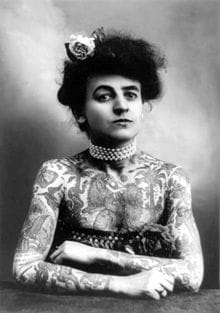
Maud Stevens Wagner, tattoo artist, circa 1907
Although Paul is bearish on the traditional tattoo scene, its demise is far from imminent or assured. Although new customers can be swayed by better marketing or what’s visible on television and celebrities, the tattoo artist core can still practice their art by working for collectors.
That is the core of their business, and collectors are more discerning and more interested in the craft of tattoos. Paul fully admits that “the old tattoo world will never die. They can keep going on the same 100 customers.” After all, imagine an artist with 100 collectors as clients. If each collector spends $2,000 a year (which is below the price of many complex tattoos), that represents $200,000 of yearly revenue for the artist and his or her parlor to split.
But will the new entrants to tattooing – who work outside their tradition of apprenticeship and devotion to the craft – appropriate much of the scene? That probably depends on whether tattoos continue their march to the mainstream. Although it’s a small world, the old school tattoo world is not elitist. They welcome more people seeking expression through tattoos. But with more people casually seeking tattoos, tattooers who can market and use good business sense will probably become the majority, and the core become a small niche.
Alternatively, if more and more people also become collectors, the core could see increased interest in their methods and scene. But for now, it’s hard to say whether the growth in the tattoo industry has included an increase in the number of collectors. The artists we spoke to were unsure. Among Millennials, half of those with tattoos have 2-5 tattoos and 18% have six or more. Maybe the number of collectors is growing. But how many of those with multiple tattoos are getting serious work done, and how many are getting basic phrases and symbols?
Tattoos have varied dramatically in meaning and popularity throughout history. The oldest remains of a human ever found, the “Iceman” from 3200 BC, was found with dots tattooed on his body that are believed to have served as acupuncture. Body art on women in Egypt may have served to protect them during childbirth. Tattoos have been associated with soldiers from Roman legionnaires to World War II sailors. They have served to mark criminals, slaves, or stigmatized groups from the Ancient Romans to Nazi Germany. At other times, they have been a sign of high birth. 19th century European gentry were so obsessed with tattoos that they disrobed after dinner to display them. In some cultures, everyone was tattooed. Others banned them entirely.
One artist compared tattoos today to rock and roll in the 1950s. Every parent hated it and every child loved it, but eventually it became the norm. Parents are embracing tattoos, but it remains to be seen if it will become as common – and what effect that will have on the people that created the American tradition of tattoos.
If the future of tattoos seems uncertain, it’s only because it always has been.
This post was written by Alex Mayyasi. Follow him on Twitter here or Google Plus . To get occasional notifications when we write blog posts, sign up for our email list .




